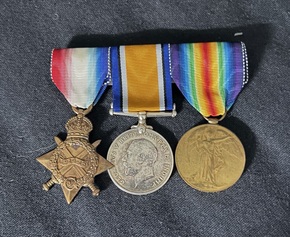SMITH, Archibald James
| Service Number: | 686 |
|---|---|
| Enlisted: | 27 September 1915, Adelaide, South Australia |
| Last Rank: | Gunner |
| Last Unit: | 11th Field Artillery Brigade |
| Born: | Horsham, Victoria, Australia, March 1876 |
| Home Town: | Port Adelaide, Port Adelaide Enfield, South Australia |
| Schooling: | Not yet discovered |
| Occupation: | Labourer |
| Died: | Natural causes, Perth, Western Australia, 12 September 1925 |
| Cemetery: |
Fremantle Cemetery, Western Australia |
| Memorials: | Kings Park Western Australia State War Memorial |
World War 1 Service
| 27 Sep 1915: | Enlisted AIF WW1, Private, 686, Adelaide, South Australia | |
|---|---|---|
| 12 Nov 1915: | Involvement Private, 686, 1st Remount Unit (AIF), --- :embarkation_roll: roll_number: '24' embarkation_place: Melbourne embarkation_ship: HMAT Orsova embarkation_ship_number: A67 public_note: '' | |
| 12 Nov 1915: | Embarked Private, 686, 1st Remount Unit (AIF), HMAT Orsova, Melbourne | |
| 24 Jul 1919: | Discharged AIF WW1, Gunner, 686, 11th Field Artillery Brigade |
Archibald James Smith’s story from his Australian Military Records
Archibald James Smith enlisted on the 29th September, 1915 at Horsham, Victoria. At the time he was 39 years of age and worked as a laborer to support his wife Ellen Amelia, and their two children. During the war the family moved around a bit to North Carlton, Victoria, Port Adelaide, South Australia and then to Perth, West Australia where Archie was eventually reunited with them after his war service.
Archie stood 5’ 8” tall and weighed 140 Lbs. He had blue eyes and dark brown hair. He initially served in the 1st Australian Remount Unit, 3rd Squadron. During World War I, the Australian Remount Units trained and cared for horses before they were shipped overseas and also while they were in the field. These units played a crucial role in ensuring the Australian Light Horse had well-trained and healthy horses for their operations, which played a crucial role in the Sinai and Palestine campaigns.
In November, 1915 Archie embarked overseas for active service and in April, 1916 he was taken into the 24th Howitzer Brigade and posted to the 111th Battery in Tel-el-Kebir. A Howitzer is a type of artillery piece that falls between a cannon and a mortar. It is capable of firing both low-angle, like a field gun, and high-angle, like a mortar, making it versatile for different combat situations.
In June, 1916 Archie travelled to Marseilles, France and joined the British Expeditionary Force. He spent a few months in the school of Artillery before being transferred to the 10th Australian Field Artillery where he served in the 39th Battery in January, 1917 until April. In April,1917 Archie was transferred to 11th Field Artillery, 43rd Battery where he served until August, 1918.
In 1917 the 10th Australian Field Artillery Brigade served in the Western Front, specifically in Belgium. They were involved in the Third Battle of Ypres, including actions near Messines and Passchendaele.
The 11th Australian Field Artillery also fought in the battles at Messines, Passchendaele, Menin Road and Polygon Wood.
Archie was not wounded, did not spend any time in hospital and had a service record with no disciplinary action. Archie’s headstone inscription says: “His duty nobly done.” This seems to be a true good description of Archie’s wartime service.
Archie’s war service in France ended in August, 1918 when he left to travel back to the U.K. He spent the next few months in England before returning to Fremantle, Australia in June, 1919. Archie was finally discharged from the A.I.F. in Perth on 24th July, 1919 ending his military service.
Judging from his grave in Fremantle Cemetery he lived out his life in West Australia before dying 12th September, 1925 only six months before his fiftieth birthday.
Submitted 10 May 2025 by Gary Wood










